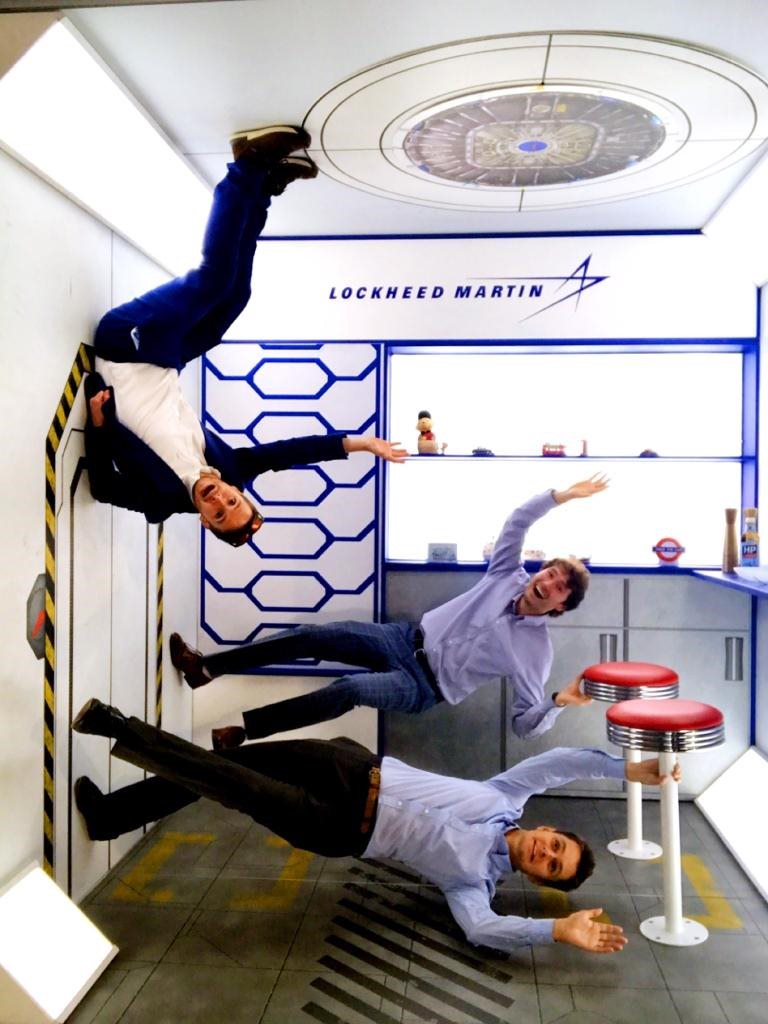
By Reece Williams, Futureworx Architect
With industry events returning in-person since the beginning of Covid-19, the Futureworx team is making use of conferences and technology showcases to network, explore, and discover the latest trends in the aerospace industry. As the Marshall Group’s venture-building arm, staying current with industry trends and developments is key to our measured risk-taking.
July saw the in-person return of the Farnborough International Airshow (FIA). The latest products and technologies that the aerospace industry has to offer were showcased, with the scale of the event and the range of technologies on display signalling that aerospace and defence are well and truly open for business.
But where is the industry headed?
The FIA provided insights spanning a range of themes. Of interest to the Futureworx team were topics including space sector innovation, sustainability with electrification and alternative fuels, advanced air mobility, and opportunities within mature air transport markets.
Space Sector Innovation

Futureworx Architects Reece, Daniel, and Alex take a trip in Lockheed Martin’s space capsule at Farnborough International Airshow (image by Lockheed Martin)
As industry professionals willing to go the extra mile for Futureworx, Alex Haigh, Daniel Gortat and myself took a brief trip into orbit courtesy of Lockheed Martin’s space capsule stand in the FIA’s space pavilion. Upon our return to terra firma, the team took the opportunity to explore the rest of the pavilion’s exhibitors.
Within the bustling community of space companies on show, two themes stood out – UK launch capability and in-space manufacturing.
Seven fledgling spaceports in Cornwall, Snowdonia, Sutherland, Prestwick, Newquay, Campbeltown and the Western Isles are putting the UK on the world map for launch capability, and commercial launches are planned to take place in the next few years. With government support from the UK Space Agency and regulations from the UK Civil Aviation Authority (CAA), will the UK meet the government’s target of capturing 10% of the worldwide space market by 2030? Watch this space for supply chain opportunities to flourish.
Meanwhile, in-space manufacturing was represented by companies such as Space Forge, a Cardiff-based start-up that is developing the world’s first returnable and re-launchable satellite platform. Its pioneering ForgeStar satellite is designed for a range of experiments and manufacturing processes to create novel and high-value materials in space. With two satellite launches planned for next year, the company aims to advance the microgravity market for off-planet research and development products.
Launch and recovery are, however, both expensive and environmentally harsh. A sustainable supply of in-space manufactured materials also requires many innovations for both economic and environmental viability. Can the UK step-up to the mark?
Electric aircraft and the future of flight

The all-electric Pipistrel Velis Electra on display at this year’s Farnborough International Airshow
Organisations are working around the world on demonstrating the viability of electric propulsion for aviation. On display at this year’s FIA was the world’s first aircraft fully certified in the EU and the UK – the Velis Electro manufactured in Slovenia by Pipistrel. The aircraft is currently under evaluation with the UK’s Ministry of Defence. With a flight time of 50 minutes (plus reserve) per charge, the pilot training sortie duration can be met with lower noise, cheaper operating costs, and zero tailpipe emissions when compared with an Avgas-fuelled equivalent.
Pipistrel has recently been acquired by US conglomerate Textron, whose aviation unit also represents Beechcraft, Cessna and Hawker brands. With such significant backing, does this mean we’ve only seen the beginning of practically useful electric aviation?
Another example on display was Alice, the world’s first all-electric commuter and eCargo aircraft developed by Israeli start-up company Eviation. After having iterated on its conceptual design, the company has converged on two fuselage-mounted magni650 electric propulsion units, each with 640 kW of power from magniX motors.
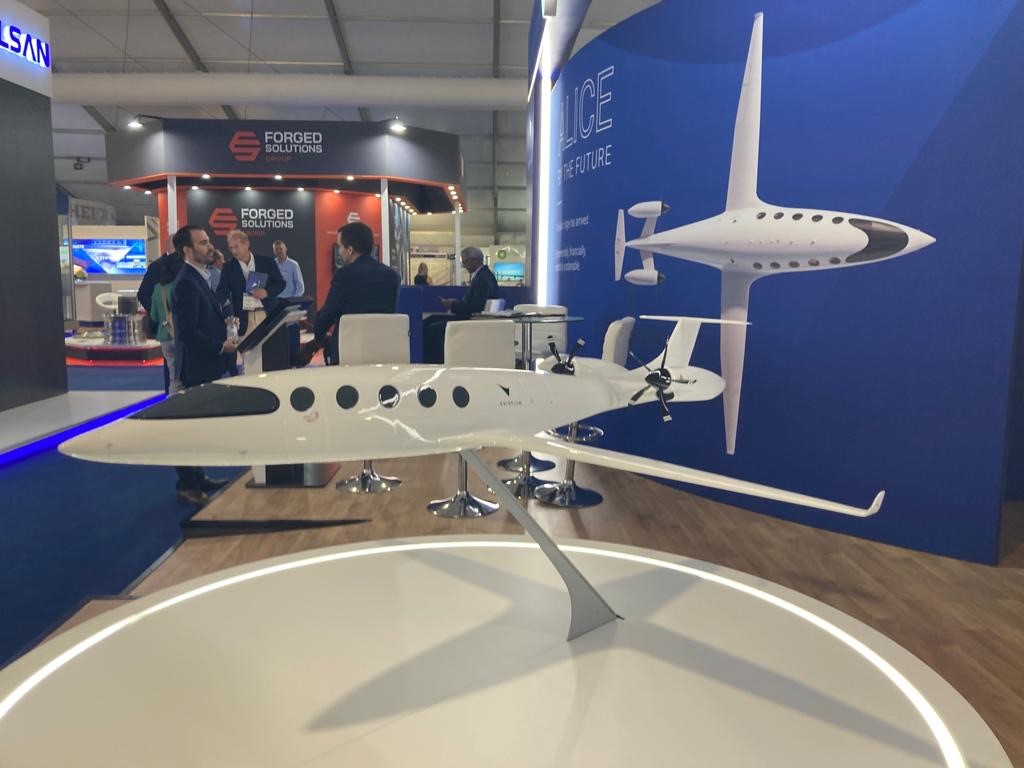
Eviation’s scale model Alice aircraft with its new ‘T’-tail and bi-motor configuration
Where is the UK’s answer to all-electric aviation? The Aerospace Technology Institute (ATI) has sponsored the Rolls-Royce Accel programme, which currently holds the new world record for the fastest all-electric aircraft of 387.4mph for its ‘Spirit of Innovation’ aircraft; while the Future Flight Challenge sponsored Enabling Aircraft Electrification (EnabEl) project has conducted test flights of the British-built eKub electric light aircraft at Little Snoring airstrip in Norfolk.
Both projects prove the UK has the innovation capability, but is there an opportunity for us to see more practically useful British electric aircraft? The net environmental benefits of electrified aircraft can only be realised with a full lifecycle consideration of environmental impact, and the security and sustainability of the original energy source is a core piece of the puzzle often overlooked.
Alternative fuels and propulsion
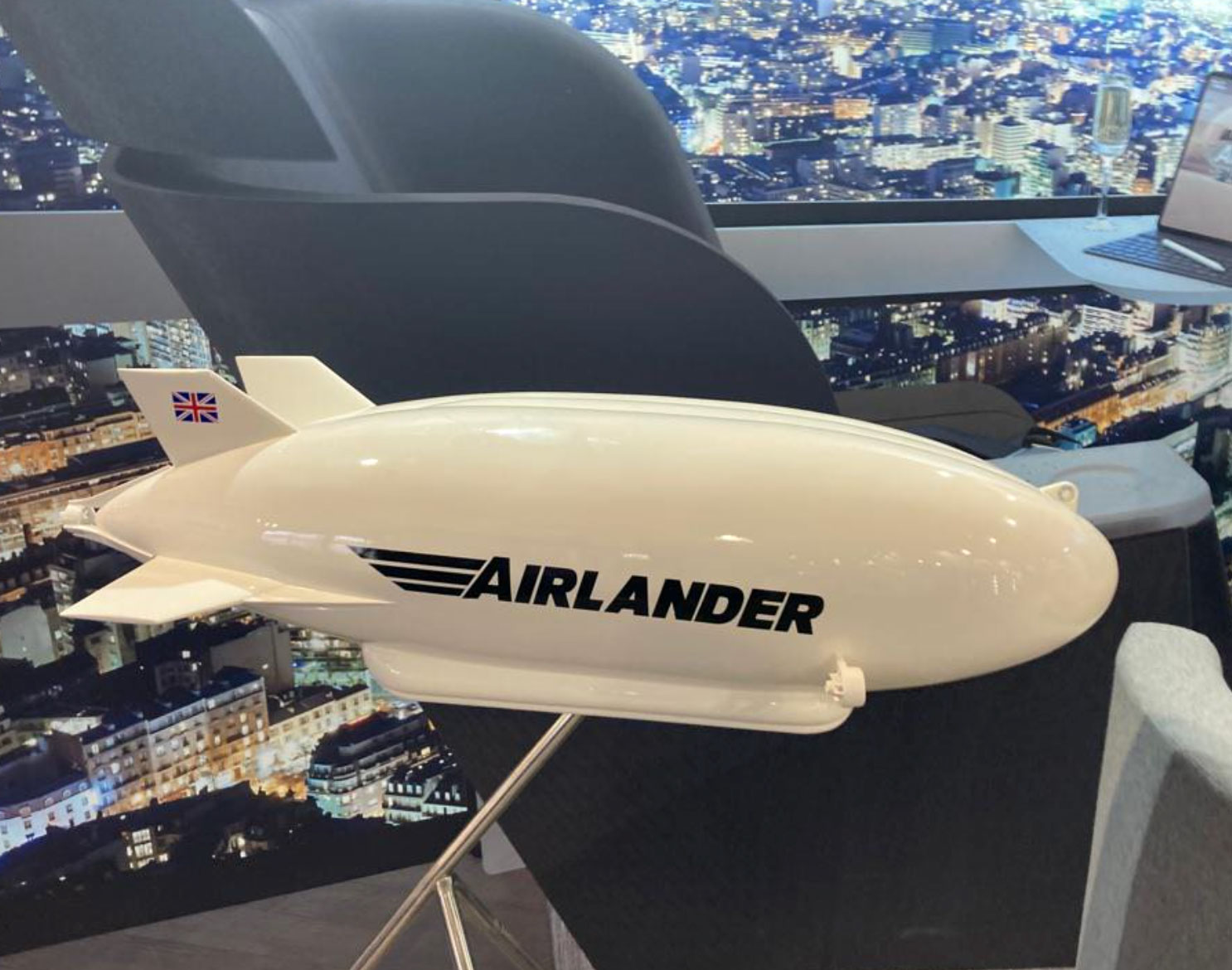
A scale model of the Airlander 10 by Hybrid Air Vehicles
In addition to electrification, there is a global drive to explore hydrogen fuel in aviation. The ATI has government support to deploy £685m of state funding into hydrogen research and development projects over the next three years.
A past recipient of such funding is Hybrid Air Vehicles, which displayed a scale model of its Airlander 10 at the FIA. Expected to be in service from 2025, the Airlander 10 intends to make use of a hydrogen fuel cell to generate energy for electric propulsion.
The ATI themselves brought a strong presence to the FIA by showcasing past, present, and aspirations for future-funded projects to drive the sustainability in aerospace agenda forwards.
Recently released research papers from its FlyZero programme provided a vision for the future of zero-carbon emission air travel. In these reports, a conceptual aircraft was scoped that could fly anywhere in the world with just one stop and zero [tailpipe] emissions. ATI has made rapid and pragmatic design considerations with this work.
However, will aviation markets accept an air-vehicle with such marked performance reductions? Time will tell whether government subsidies and geopolitical pressure take precedence over free-market forces. After all, Ryanair boss Michael O’Leary recently proclaimed that the era of cheap flights is over.
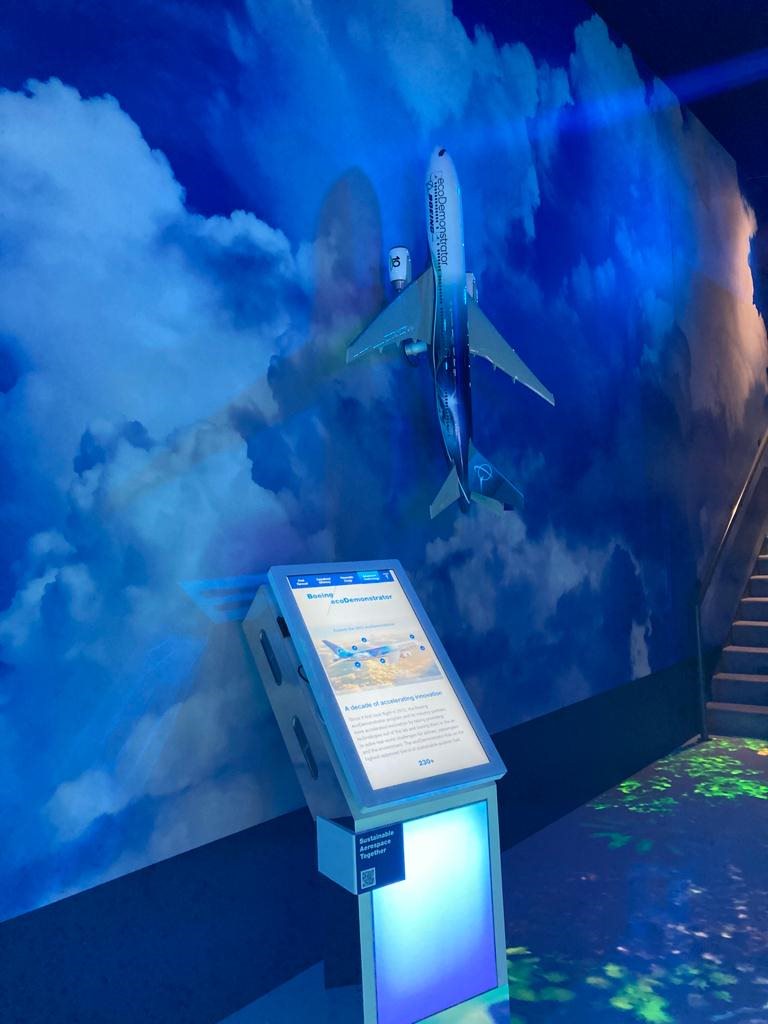
A scale model of Boeing’s latest 777-200ER ecoDemonstrator
Elsewhere, Boeing presented an indoor hall showcasing its ecoDemonstrator aircraft.
So far, nine aircraft have served as ‘flying test beds’ for new technologies that aim to improve sustainability and safety in the aerospace industry, including Sustainable Aviation Fuels (SAF) which are key to Boeing’s future strategy that has a notable lower emphasis on hydrogen.
What now for conventional aircraft?

Futureworx Architects Reece, Daniel, and Alex next to the Rolls-Royce UltraFan mock-up
The Boeing 737 MAX and Airbus A350 both provided stunning air displays at this year’s FIA, reminding spectators of the true power and capabilities of these machines. The order books of the largest aircraft manufacturers, following further deals announced at the event, appear healthy – multiple aircraft are rolling off the production line every day.
With passenger traffic numbers widely forecast to recover by 2024, it is worth noting that the opportunities with conventional aircraft remain huge.
Rolls-Royce had an impressive display of its UltraFan engine at the FIA. Promising a sustainable solution ‘for decades to come’, the UltraFan engine – the largest of its kind in the world – is designed to run on 100% SAF from day one of service and boasts a power gearbox that delivers 64MW on test, an aerospace power record.
Advanced air mobility markets
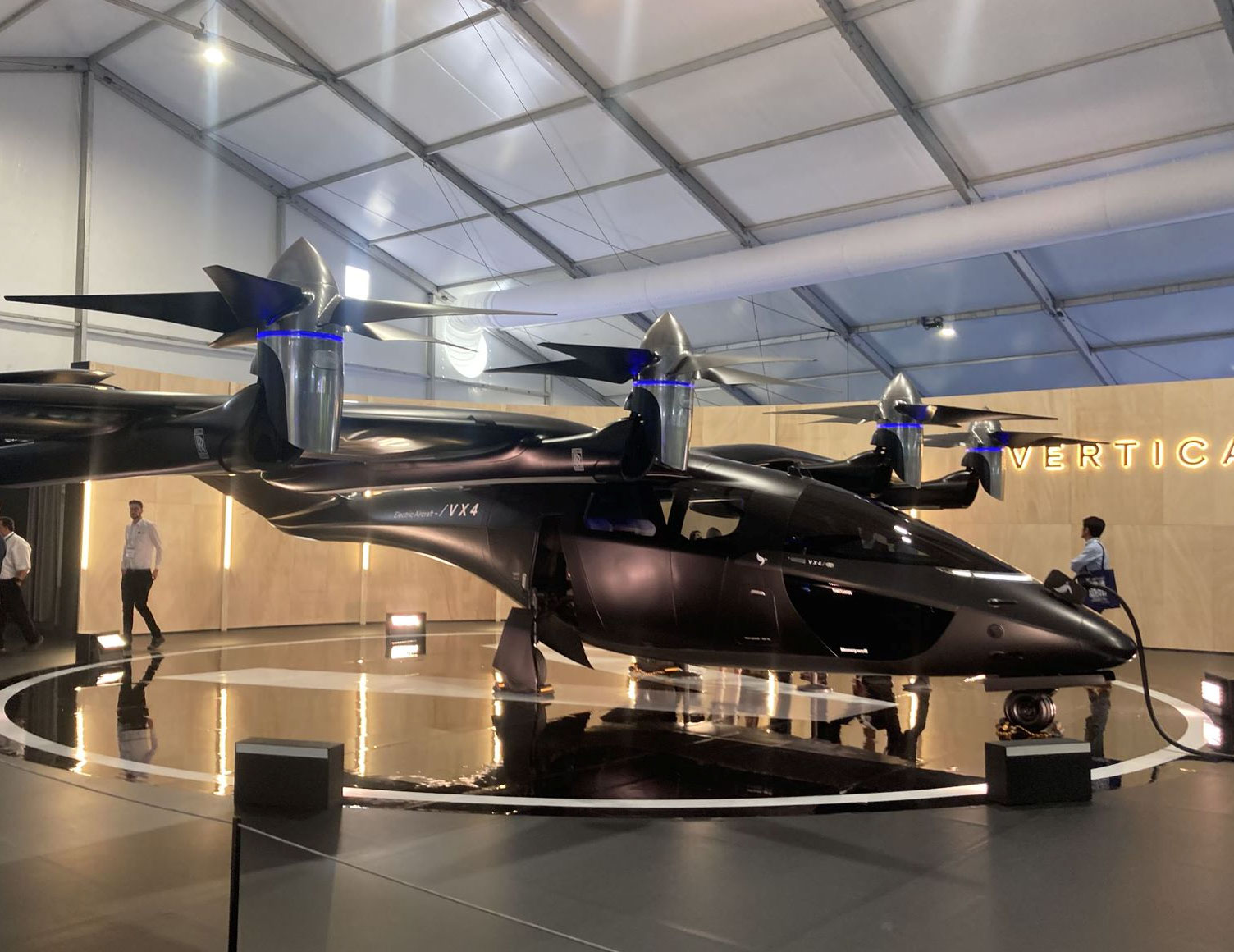
Vertical Aerospace’s stunning full-scale model of the VX4 with full interior
With significant advancements in control systems, modelling and simulation, advanced composites, stored energy, and propulsion technologies in the last decade, newly enabled novel air-vehicles were also on show at the FIA.
Companies working with advanced air mobility (AAM) and electric Vertical Take-Off and Landing (eVTOL) aircraft have certainly captured the imaginations of investors worldwide. German start-up Lilium has reportedly raised almost $1bn to date and the UK’s Vertical Aerospace has pursued a similar reverse-merger SPAC float.
There are many other AAM companies globally, including the American companies Wisk Aero and Joby Aviation to name a few. But did this mean that certified aircraft were dazzling audiences at the airshow? Well, not quite, but glamourous looking booths and scale mock-ups are the next best thing.
Indeed, this year saw Vertical Aerospace showcasing its stunning full-scale model of the VX4. The Bristol-based company is converging on a design with four electric propulsors enabling vertical lift and transition into wing-borne lift. The company has also employed a diverse team with decades of certification experience, thus giving them a chance of navigating the emerging regulations.
Lilium displayed only a scale model of its Lilium Jet but held a large screening of the aircraft’s most recent test flight. The Wessling-based company claims to have achieved its first demonstration of transitioning from vertical take-off to horizonal flight and wing-borne lift.
These companies are innovating technically and challenging the status quo with regards to air mobility – just as many have in history. It’s worth noting, however, that lessons from the past have proved that vertical flight is economically and technically challenging. The Bell Boing V-22 Osprey tiltrotor military aircraft entered service in 2007 requiring in excess of $30bn of development costs and an hourly ownership cost of $83,000. Does this mean eVTOL has only just started, or will this modern technology open vertical flight to the masses? If investment keeps flowing, it will be exciting to see which companies take AAM from technology demonstrator to commercial success.
The Futureworx team will be attending this month’s Drone-X trade show and conference in London to learn more about other vertical lift and applications of UAV autonomy.
All images by Reece Williams except where stated.